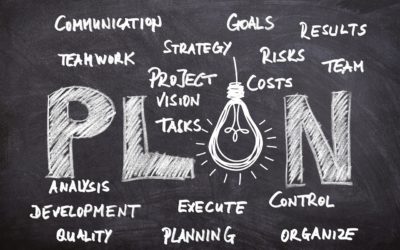Struggling to navigate the complexities of strategic planning in today’s fast-evolving business environment? Discover how Objectives and Key Results (OKRs), a pioneering approach birthed in Silicon Valley, are reshaping the landscape of strategic planning. Our series at GrowthTailor.com delves into the transformative impact of OKRs, from driving Intel’s success to becoming a staple in agile business strategy.
Part of the OKRs Blog Series on GrowthTailor.com
Welcome to the first article of our new blog series at GrowthTailor.com, where we explore the world of Objectives and Key Results (OKRs). Recently, I’ve been struck by how little is known about OKRs, despite the challenges many face in creating and executing effective, actionable plans. The onset of Covid and recent wars have thrust our world into a state of unpredictability, emphasising the need for agile business planning and resilience.
In today’s fast-paced and often unpredictable business landscape, strategic planning is more crucial than ever. However, traditional approaches may fall short in addressing the complexities of the modern world. This is where Objectives and Key Results (OKRs) come into play. Emerging from Silicon Valley’s innovative spirit, OKRs offer a dynamic approach to strategic planning, aligning ambitious goals with practical execution. As part of our series on GrowthTailor.com, we’ll explore how OKRs have transformed strategic planning, enabling businesses like Intel and Google to navigate through uncertainty with clarity and agility.
Through this series, we aim to explore how OKRs can be a pivotal tool in navigating these turbulent times.
The Need for Agility and Resilience in Modern Business
Our current global landscape is a testament to uncertainty. Businesses are continually grappling with rapid changes and unforeseen challenges. This new reality demands a shift from traditional, rigid planning methods to more flexible and resilient approaches.
It’s here that we believe OKRs can make a significant impact. They offer a framework that not only adapts to change but thrives on it, aligning teams towards common goals while allowing for agility in execution.
How OKRs Differ from Other Goal-Setting Tools
Before digging into the topic of OKRs, it might be useful to answer a common question we often get asked: Aren’t OKRs just some kind of KPIs? Answering this question is less straightforward than it may seem. OKRs (Objectives and Key Results) are increasingly recognised as a cornerstone of strategic planning, distinguishing themselves from traditional tools like KPIs (Key Performance Indicators) with their unique approach to setting and achieving goals.
OKRs vs KPIs: A Detailed Look
- Focus and Flexibility: OKRs are about setting ambitious, aspirational goals with clear, measurable outcomes that encourage teams to think expansively and innovate. KPIs are more about evaluating the success of existing processes, with a focus on maintaining and improving current performance.
- Alignment and Engagement: OKRs align efforts across all levels of an organisation, linking individual objectives to the company’s broader vision. KPI-driven models tend to concentrate more on measuring performance without necessarily aligning it with overall strategic objectives.
- Adaptability: The adaptability of OKRs allows for recalibration in response to changing business landscapes. KPIs are usually more fixed, serving as consistent benchmarks that may not reflect rapid strategic or market shifts as readily.
Beyond KPIs: The Unique Value of OKRs
While KPIs play a critical role in performance tracking, OKRs offer a more holistic approach, integrating various business facets to achieve collective success. They foster a culture of transparency and accountability, with progress and goals shared openly across the organisation. Moreover, OKRs encourage a continuous feedback loop, contrasting with the static nature of traditional goal-setting which often relies on annual or semi-annual reviews.
Incorporating OKRs into your strategic planning offers a dynamic and engaging framework, radically different from the traditional methods and tools like KPIs. It’s a strategy designed not just for incremental improvement but for quantum leaps in performance and innovation.
For a deeper exploration of how OKRs can complement other effective goal-setting methodologies within your strategic business plan, like like MBO, SMART goals, and BSC, please check our article: “Popular Goal-Setting Methodologies to Empower Your Strategic Business Plan.” This piece describes the synergies and distinctions between various frameworks, empowering you with the knowledge to excel in strategic business planning.
Let’s now continue exploring OKRs.
OKRs: Blending Ambition with Practical Execution
Objectives and Key Results (OKRs) are more than just a business buzzword; they are a lifeline in times of uncertainty. Born in the heart of Silicon Valley and popularised by companies like Intel and Google, this methodology has proven its worth across various industries. In this series, we aim to unravel the essence of OKRs, starting with their fascinating origin at Intel under the visionary leadership of Andy Grove.
Setting the Scene: Understanding OKRs
Before diving into the history and application of OKRs, it’s important to understand what they entail. OKRs are a goal-setting framework used by teams and individuals to define measurable objectives and track their outcomes. The beauty of OKRs lies in their simplicity and flexibility, allowing organisations of all sizes to focus on what truly matters – achieving key results that drive progress and innovation.
Series Overview: Uncovering the World of OKRs
Our series will guide you through every aspect of OKRs – from their historical roots to practical application in today’s dynamic business environment. Here’s what you can expect:
- The Origin of OKRs: Discover how OKRs emerged as a transformation tool at Intel and how they have evolved since then in this article below.
- Setting Effective OKRs: Learn how to create clear, impactful objectives and measurable key results.
- Execution and Adaptation: Understand how to implement OKRs in your organisation and adapt them to changing circumstances.
- Case Studies and Success Stories: Explore real-world examples of how OKRs have driven success in various organisations.
- OKRs in Unpredictable Times: Delve into the role of OKRs in fostering business resilience during uncertain periods.
Andy Grove’s Visionary Leadership and the Invention of OKRs
The birth of OKRs can be attributed to the legendary CEO of Intel, Andy Grove. In the early 1970s, Grove introduced OKRs as a means to transform the company’s management culture and drive growth. He recognised the need for a framework that could set clear and ambitious goals, foster transparency and accountability, and align individual efforts with the company’s overall strategy.
Initially, OKRs faced resistance from some employees at Intel, who were accustomed to more traditional management approaches. However, Grove’s unwavering commitment to the framework eventually won over the sceptics, and OKRs became an integral part of Intel’s corporate DNA.
OKRs: A Driving Force Behind Intel’s Success
The implementation of OKRs at Intel was a pivotal decision. This framework helped the company achieve remarkable success in the semiconductor industry, fostering innovation, market leadership, and sustained growth. OKRs became essential for setting ambitious targets, aligning teams, and measuring progress towards company goals.
Under OKRs, Intel’s R&D teams were encouraged to push the boundaries of innovation, leading to the development of groundbreaking microprocessors and technological advancements that shaped the computing landscape. The focus on continuous improvement and strategic alignment enabled Intel to adapt to the ever-changing demands of the technology industry.
The Global Spread of OKRs
Intel’s success with OKRs did not go unnoticed. The framework quickly gained traction beyond the company’s walls, attracting attention from other Silicon Valley giants, including Google, which adopted OKRs in the early 2000s. Today, OKRs are utilised by organisations worldwide, from Fortune 500 companies to small startups.
Conclusion: OKRs Supportive in Today’s Unpredictable World
Our series aims to explore how OKRs can be a pivotal tool in navigating the unpredictability of the modern business landscape. The enduring success of OKRs stems from their ability to balance ambitious goals with practical execution, providing a clear roadmap for achieving success while maintaining focus and accountability.
As we continue to face complex challenges and rapid changes globally, OKRs remain an essential framework for organisations seeking to navigate uncertainty and drive sustainable growth.
Join Us on This Journey
We invite you to join us on this enlightening journey as we uncover the power of OKRs. Whether you’re a seasoned professional or new to the concept, our series promises insights and strategies to help you steer your organisation towards success, even in the most unpredictable times.
Stay tuned for our next post, where you will learn how to make use of OKRs. You can register for our newsletter as well, so you will directly receive new articles when they are ready.
Please be part of our community and share your thoughts and ideas below.
Featured Images source: Photo by Chang Duong on Unsplash




